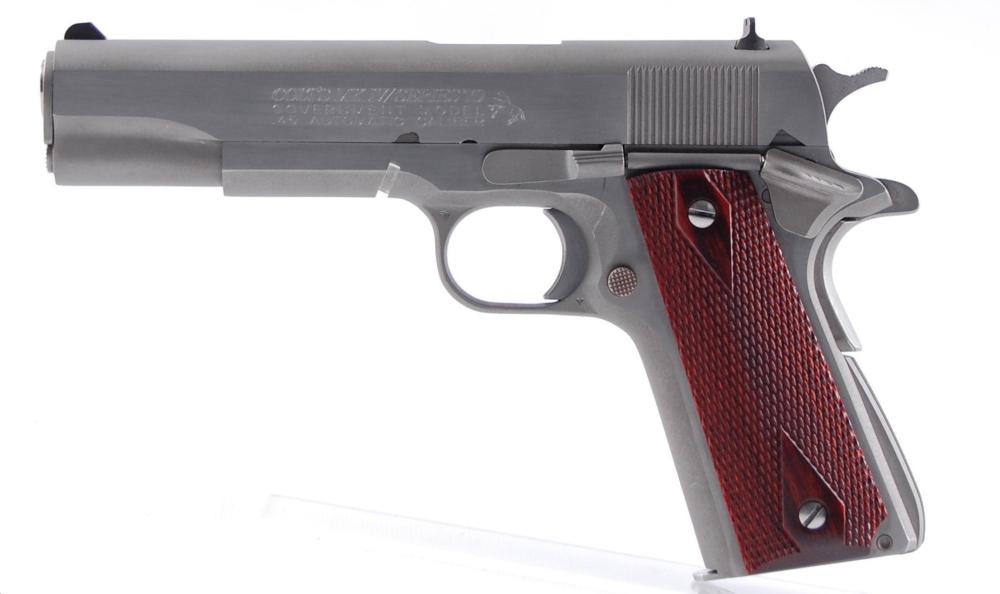First off, a basic comparison of the new 'Second Generation' Series 70 pistols with the originals is in order. As already mentioned the new guns use the solid barrel bushing, whereas the 1st Gen. guns used the cullet bushing. Both lack the Series 80 firing pin safety, however the new pistols do use the same internal parts as the Series 80 pistols. In other words, the extractor, firing pin, and grip safety have the notches cut into them that would have allowed the FPS parts to function. There are however no cutouts in either the slide or the frame for the levers and plunger, which means that a firing pin safety cannot be retrofitted to these guns without making the additional machining passes that a Series 80 gun requires. This all may sound like a cheap cop-out at first, but one must look at it from Colt's standpoint. Series 80 parts are fully backwards compatible in Series 70 guns, as the 'notched' parts do not affect function and aren't even noticeable when the gun is completely assembled. In the name of streamlining its spare parts network Colt dropped all of the older Series 70 parts from production many years ago, and existing owners of older pistols are merely expected to order S80-type replacement parts which of course will still work fine. There was simply no point in making these older parts all over again just for a limited-production Custom Shop item, and so the new Series 70 guns use the exact same internal parts as the other current pistols in Colt's product line. It is worth mentioning that Colt did the exact same thing with the WW2 repro M1911A1, meaning that model uses S80-type internal parts as well.
The sights on the new guns are also from current production, as they are identical to the plain, high profile ones used on Colt's M1991A1 model. They are very similar to the original mil-spec sights of the originals, but they are taller and wider and allow a much better sight picture than the tiny sights of old. While not exactly period correct, as with the collet bushing they are probably another departure from the original that few owners will mind. If you intend to shoot your new S70 on a frequent basis you'll no doubt appreciate having sights you can actually see. The grips are rosewood checkered in the traditional fashion, with a large diamond surrounding each screw hole. The are supplied on contract by the Chip McCormick Corporation, and in the opinion of this author look much nicer than the plain checkered or rough-sawn wood grips of the originals. I do however miss the gold Colt medallion that was inset into each grip panel on the originals. On the positive side they're only grips, and if you prefer the original style they're not too hard to find at gun shows or on eBay.
There is another internal change in the new pistols, and it's definitely a welcome one. The barrel ramp/chamber entry throat is a new style designed to allow reliable feeding of all bullet shapes, yet at the same time not allow an excessive amount of case brass to be left unsupported. It looks like two ramps in one, first a large sweeping ramp then a much smaller 'dimple' right at the 6 O'clock position. The setup works perfectly in ensuring reliability, yet is much safer than the older and more common method of creating a huge, sweeping entry throat that would often leave unsupported brass at the bottom. Many new Colt owners unaware of this new setup have incorrectly assumed that their new pistol isn't 'throated for hollowpoints', and have sent their guns off to a gunsmith for a 'reliability package'. Trust me, the new setup works much better than the old one. I don't know if Colt has patented it, but if not I think the other 1911 makers should follow Colt's lead. The final internal difference with the new guns was only present on the first run of pistols such as mine, and that was that the slide stop cutout in the frame was completely milled away as on other current Colt production. With the second run of pistols the bridge of metal on the frame rail above the cutout is retained, as on the 1st Gen. Series 70 pistols.
The ejection port is the same as with the originals, meaning the opening is narrow and has the high lip on the right side of the slide. Most new 1911 pistols have a lowered port to allow better ejection, but the narrow port is a concession to authenticity. The trigger is made of steel, with a serrated face as on the originals. The flat surfaces of the slide and frame are polished, which contrasts beautifully with the sandblasted matte surfaces present on the rounds. The color of the factory bluing and level of polish isn't quite as bright as on the originals, but it is still pleasing to the eye and nowhere near as dull as most other contemporary firearms. Sadly, bright-polished blue guns seem to be an endangered species these days so I'll gladly take any attempt to replicate the finishes of old! The mainspring housing is nylon, which is a faux pas to my mind since many purists dislike plastic in any form on a 1911, and probably don't expect to see it anywhere on this pistol! However, the fact is the nylon housing has no other adverse affects and won't suffer finish wear like a steel housing will. Lastly, the slide rollmarks are almost identical to the original guns and are very pleasing to the eye. Thankfully Colt chose to use the small slide legend of the late 70's-early 80's guns, and not the huge, ugly billboard-sized rollmarks of the first Series 70 pistols! The serial number is unusual however in that it's laser-etched, with a 71B prefix. The originals were of course stamped. It remains to be seen whether the shallow serial numbers on the new guns might present a problem if a gunsmith were to later attempt a polish and reblue job on the frame. On some pistols I have examined the serial numbers are so light they're hard to see as it is. Monopoly here now edition download.
Over the past few months of ownership I have had a chance to fire several hundred rounds out of my new second generation Series 70. So far there have been no problems with malfunctioning whatsoever. Accuracy has also been very good for an out of the box Colt pistol. While I haven't had a chance to make pretty 25-yard benchrested groups with it, my estimation is that it can easily hold under 3 inches with most loads. Better accuracy than that isn't needed unless you're shooting Bullseye matches, in which case you'll need a specially accurized weapon for that anyway. The trigger pull on my example is very good, relatively smooth and clean and around 4-5 pounds. With a smooth letoff even a heavy trigger will feel lighter than it really is, and you'll have an additional hedge against an accidental discharge as well. Overall feel and functioning with this pistol is one of quality. The slide action is silky-smooth, with hardly any feel of the parts bumping into one another as the slide moves back and forth on the frame. The controls all operate smoothly and positively, and the slide to frame fit is snug. Note that I said snug, not tight. While some manufacturers seem obsessed with super-tight 1911s that have absolutely no play in the mechanism anywhere, Colt seems a little smarter than most and allows for a little play. Those individuals who sneer at Colt products just because their slides and frames sometimes rattle a little bit either don't realize, or else don't care that a small amount of clearance was purposely designed into the 1911 for the sake of reliability. A tight 1911 might be more accurate, but it won't be more reliable because of it! Don't listen to those custom gunsmiths who say otherwise either, despite the fact that some very big names in the industry still claim that tight 1911s are more reliable. Their arguments simply don't hold up when you stop and think about it. Probably the most reliable 1911s ever made were the old GI guns, which were often fitted so loose they sounded like a baby rattle yet developed a reputation for utter reliability under battlefield conditions. By contrast, if you watch at a local shooting match it seems most folks hitting and cursing at their 1911s are using expensive, accurized, tightly-fitted guns! Hmmmmm...
Based on my experience, I can state that the new Series 70 Government Model from Colt is a keeper. I do not know just how long they will remain in production however, as they are considered Custom Shop items so production is bound to be limited. So if you really like the idea of a brand-new Colt .45 built along the lines of the classic Colts of old I'd suggest not waiting to pick one up. Do be prepared for a little sticker shock, however.
Colt 1911 Mkiv Series 70 Serial Numbers 222
Copyright 2002 D. Kamm
Copyright © 2001-2005
[www.CoolGunSite.com]
All rights reserved.
Revised: 02/13/08
Colt Series 80 Value


